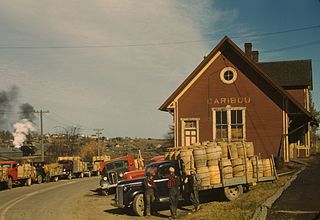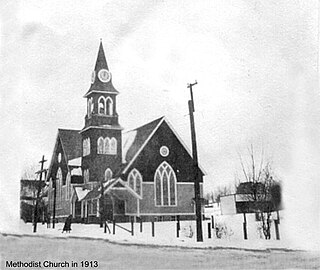
Caribou is the second largest city in Aroostook County, Maine, United States. Its population was 7,396 at the 2020 census. The city is a service center for the agricultural and tourism industries, and the location of a National Weather Service Forecast Office.

Presque Isle is the commercial center and largest city in Aroostook County, Maine, United States. The population was 8,797 at the 2020 Census. The city is home to the University of Maine at Presque Isle, Northern Maine Community College, Northern Maine Fairgrounds, The Aroostook Centre Mall, and the Presque Isle International Airport.

The Bangor and Aroostook Railroad was a United States railroad company that brought rail service to Aroostook County in northern Maine. Brightly-painted BAR boxcars attracted national attention in the 1950s. First-generation diesel locomotives operated on BAR until they were museum pieces. The economic downturn of the 1980s, coupled with the departure of heavy industry from northern Maine, forced the railroad to seek a buyer and end operations in 2003. It was succeeded by the Montreal, Maine and Atlantic Railway.

Fort Kent, located at the confluence of the Fish and Saint John rivers in the town of Fort Kent, Maine, United States, is the only surviving American fortification built during the border tensions with neighboring New Brunswick known as the Aroostook War. It is preserved as the Fort Kent State Historic Site, which features an original log blockhouse that is open for visits in the summer. The fort was added to the National Register of Historic Places in 1969 and declared a National Historic Landmark in 1973.

State Route 210 (SR 210) was a state highway entirely in Presque Isle, Maine. It ran in a 6.1-mile (9.8 km) loop from the intersection of U.S. Route 1 (US 1) and SR 164 along the north and west side of the Aroostook River before turning to the west and ending at US 1. The route was originally designated in 1925, and ran between Fryeburg and North Waterford. During the renumbering, it became part of SR 5. Between 1937 and 1938, the number was applied to the loop built as a service road for the Northern Maine Sanitarium. Even after the closure of the sanitarium in the 1970s, the road along which the state route ran remains open and in use.
The Roosevelt School is a historic former school building on Maine State Route 161 in Saint John Plantation, Maine. Built in 1920 to a standard plan and used as a school until 1969, it is the only surviving historic school building in the small rural community. It was listed on the National Register of Historic Places in 1992.

The Gray Memorial United Methodist Church and Parsonage is a historic church complex at 8 Prospect Street in Caribou, Maine. The Gothic Revival wood-frame church, built in 1912-14 for a Methodist congregation founded in 1860, is the most architecturally sophisticated church in Caribou. It was built on the lot of the Colonial Revival parsonage house, which was moved to make way for the church. The complex was listed on the National Register of Historic Places in 1995. The current pastor is Rev. Timothy Wilcox.

The Aroostook County Courthouse and Jail is located on Court Street in the center of Houlton, Maine. The building was built in 1859 and was added to the National Register of Historic Places on January 26, 1990. Its oldest portion dates to 1859, built to a design by Gridley J. F. Bryant, and was the county's first purpose-built court facility. Later additions in 1895 and 1928 added wings that give the building its present shape. It was listed on the National Register of Historic Places in 1990.

The William Goold House is a historic house at 280 Windham Center Road in Windham, Maine. Originally built in the year 1775 and later rebuilt in 1802, it was the longtime home of William Goold, a prominent 19th-century historian of the state of Maine and a state senator. It was listed on the National Register of Historic Places in August 1990.

The Philo Reed House is an historic house at 38 Main Street in Fort Fairfield, Maine. Built in 1907 to a design by Coombs and Gibbs, it is one of the town's grandest houses, a transitional combination of Queen Anne and Colonial Revival styling. It was built for Philo Reed founder of one of the nation's largest seed potato companies of the time. It was listed on the National Register of Historic Places in April 1986.
The Benjamin C. Wilder House is an historic house at 1267 Main Street in Washburn, Maine, United States. Built about 1852, it is a well-preserved example of mid-19th century vernacular architecture in northern Aroostook County, built in the first decade after widespread settlement began of the area. The house was listed on the National Register of Historic Places in 1987. It is now owned by the local Salmon Brook Historical Society and operated as a historic house museum.
Aroostook State Park is public recreation area within the southern municipal boundary of the city of Presque Isle in Aroostook County, Maine. The state park's 898 acres (363 ha) encompass Quaggy Jo Mountain and sit adjacent to Echo Lake. "Quaggy Jo" is an altered version of the mountain's Native American name, "Qua Qua Jo", which means "twin-peaked."

The Radka–Bradley House also known as the Bradley House, was built as a private house at 176 West Michigan Avenue in Rogers City, Michigan. It was listed on the National Register of Historic Places in 1991, and is now the Presque Isle County Historical Museum.
The Beecher H. Duncan Farm, also known as Brookvale Farm, is a historic farm property at 26 Shorey Road in Westfield, Maine. Built in 1910-12, the farm complex, it is a well-preserved family farm dating to the period of Aroostook County's heyday as a potato growing area. It was listed on the National Register of Historic Places in 2009.
The Elms, also known as the Boardman J. Stevens House and the George W. Richards House, is a historic house at 59 Court Street in Houlton, Maine. Built c. 1872 as a fine example of Second Empire architecture, it underwent a significant alteration between 1906 and 1912 in which high-quality Craftsman styling was introduced to its interior. The building was listed on the National Register of Historic Places in 2009 for its architectural significance.
The Squire Ignatius Haskell House is a historic house at 20 Main Street in the center of Deer Isle, Maine. Now home to the Pilgrim's Inn, this wood-frame house was built in 1793 by one of the maritime community's leading men, and is one of its oldest buildings. It was listed on the National Register of Historic Places in 1978.
The Anders and Johanna Olsson Farm is a historic farmstead at 354 West Road in New Sweden, Maine, United States. It includes surviving elements of both a log house and log barn built in the late 19th century by Anders Olsson, a Swedish immigrant. The barn is the only known surviving barn in Maine to have been built during the wave of Swedish immigration in the later decades of the 19th century. The property was listed on the National Register of Historic Places in 1996.
The former Presque Isle National Bank building is a 19th-century commercial building at 422 Main Street in Presque Isle, Maine. Built in 1887, it is one of the most architecturally significant commercial buildings of northernmost Maine, and was listed on the National Register of Historic Places in 1986 for its architecture. It presently houses the Maine Farmers Exchange on the upper level, and retail stores below.
Sunset Lodge is a historic summer lodge on the shore of Madawaska Lake in rural northern Aroostook County, Maine. It is a peeled log structure, built in 1932 by Bruce Ward, founder of Ward Cedar Log Homes, and early marketer of log structures for recreational and year-round living. The building was listed on the National Register of Historic Places in 1994.
The Presque Isle Main Post Office is located at 23 Second Street in Presque Isle, Maine. It is located in a Classical Revival brick building, constructed in 1932. The building was listed on the National Register of Historic Places in 1986.










